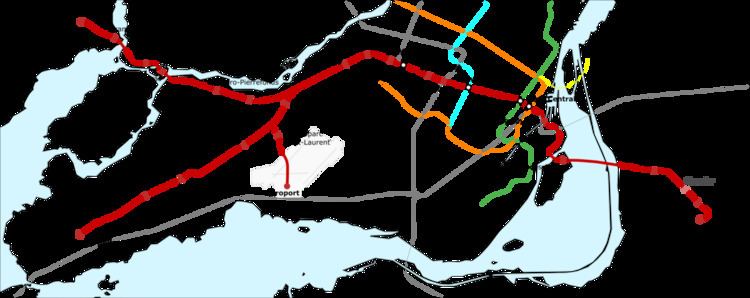Locale Greater Montreal Number of lines 3 Daily ridership 167,000 (projected) | Transit type Rapid transit Number of stations 27 | |
 | ||
Owner Caisse de dépôt et placement du Québec | ||
The Réseau électrique métropolitain (REM; English: Metropolitan Electric Network) is a planned rapid transit system for the Greater Montreal area around Montreal, Quebec, Canada. The system would link several suburbs with Downtown Montreal via Central Station, involving the conversion of the existing Deux-Montagnes commuter rail line to rapid transit standards. A station at Montréal-Pierre Elliott Trudeau International Airport would serve as the terminus of one of the four branches.
Contents
The 67 km long system would be built at an estimated cost of $5.9 billion, independent from the existing rubber-tyred Montreal Metro operated by STM. The Caisse de dépôt et placement du Québec is expected to contribute $3.1 billion for the new system, with help from Transport Canada and Transports Québec to cover the rest.
Trains on the network are expected to be fully automated and driverless, becoming the third largest automated rapid transit system in the world, after Singapore (82 km), and the Vancouver Skytrain (79.5 km).
History
On January 13, 2015, Quebec premier Philippe Couillard and Michael Sabia, CEO of Caisse de dépôt et placement du Québec (CDPQ) agreed to a partnership in which the crown corporation would assume financing for major transportation projects in the province, with $7.4 billion planned to be spent on infrastructure from 2014 to 2024.
On April 22, 2016, Sabia and Montreal mayor Denis Coderre unveiled the project to the media. According to Sabia, construction is expected to begin in May 2017 with a completion date in late 2020 or early 2021. It was subsequently clarified that this completion date would require a financial commitment from the federal government before the end of 2016.
On June 22, 2016, CDPQ Infra, published two requests for qualification; one for the engineering, procurement and construction contract and a second for the rolling stock, systems, operation and maintenance. The estimated value of the two contracts are C$4 billion and C$1.5 billion respectively.
On November 25, 2016, CDPQ Infra announced the addition of three new stations to the Réseau électrique métropolitain (REM) project. The Bassin Peel, McGill and Édouard-Montpetit stations will significantly improve downtown Montreal service and further integrate the REM into the Metro system through fluid and efficient connections to the Orange, Green and Blue lines. This announcement will adjust the price tag of the entire project to a total $5.9 billion.
Route
The primary route is based around the Mount Royal Tunnel, where new underground stations are proposed to be built to connect with the existing McGill and Édouard-Montpetit Metro stations. New connections with commuter rail would be built at Canora (to the Saint-Jérôme line) and a new station near the A-40 (to the Mascouche line).
Southeast from Gare Centrale, the line follows existing rail lines past Cité du Havre and cross to Île des Sœurs, then uses a rail deck constructed on the new Champlain Bridge to cross the St. Lawrence. Three stations in Brossard on the south shore would be built: Panama, Du Quartier (for the DIX30 commercial district), and Rive-Sud; while one station, Chevrier, is part of future plans.
The northwest branch would be a direct conversion of the existing Deux-Montagnes line, requiring doubling of the tracks beyond Bois-Franc station. New branch routes on the West Island would begin near the A-13, with the airport branch making a stop in Technoparc St-Laurent before terminating at Montréal–Pierre Elliott Trudeau International Airport, while the other branch follows an existing rail corridor through Pointe-Claire and Kirkland, before terminating in Sainte-Anne-de-Bellevue.
In the city center, three stations would be built to interconnect with existing metro lines; McGill would connect with the Green Line, Édouard-Montpetit would connect with the Blue Line and Bonaventure Gare Centrale would connect with the Orange Line.
Criticisms
In a report prepared by the Bureau d'audiences publiques sur l'environnement (BAPE) and released on January 20, 2017, the REM project was severely criticized. In the words of one journalist, “the BAPE threw a cold shower on the REM “
Notably, the BAPE pointed to a lack of crucial information being provided on this project regarding the financial model, the environmental impact, and the impact on ridership levels throughout public transit networks around Montreal. Without such information, the BAPE declared that it was “premature to authorize the realization of this project.”
The BAPE also estimated that CDPQ Infra did not meet its obligations for transparency by not providing information in a timely fashion on ridership levels of the REM's three antennaes (route branches).
The CDPQ Infra was also reproached for not studying the impact of the REM on existing public transit authorities.
CDPQ Infra was criticized for never answering basic questions such as “how much tickets will cost”, “will municipalities served by the REM have to pay by themselves to provide necessary infrastructures for access to the REM”, and “will municipalities also have to contribute to operations of the REM”
